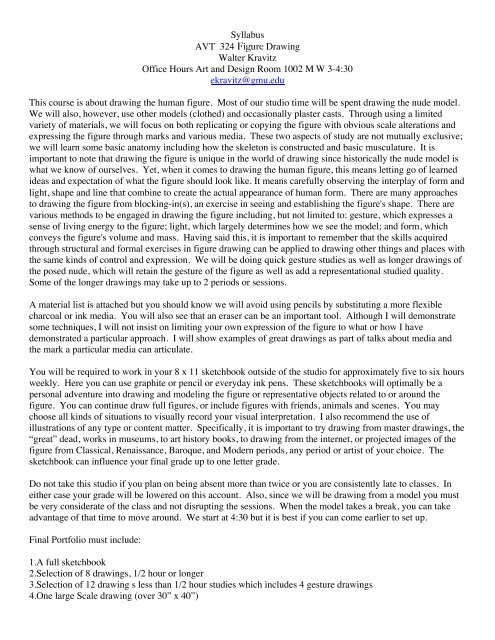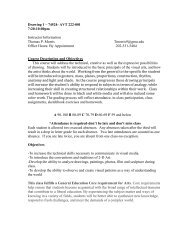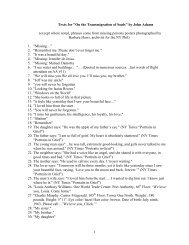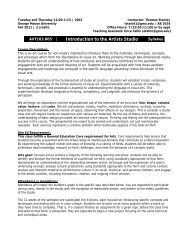324 Figure Drawing Kravitz.pdf - George Mason University
324 Figure Drawing Kravitz.pdf - George Mason University
324 Figure Drawing Kravitz.pdf - George Mason University
Create successful ePaper yourself
Turn your PDF publications into a flip-book with our unique Google optimized e-Paper software.
SyllabusAVT <strong>324</strong> <strong>Figure</strong> <strong>Drawing</strong>Walter <strong>Kravitz</strong>Office Hours Art and Design Room 1002 M W 3-4:30ekravitz@gmu.eduThis course is about drawing the human figure. Most of our studio time will be spent drawing the nude model.We will also, however, use other models (clothed) and occasionally plaster casts. Through using a limitedvariety of materials, we will focus on both replicating or copying the figure with obvious scale alterations andexpressing the figure through marks and various media. These two aspects of study are not mutually exclusive;we will learn some basic anatomy including how the skeleton is constructed and basic musculature. It isimportant to note that drawing the figure is unique in the world of drawing since historically the nude model iswhat we know of ourselves. Yet, when it comes to drawing the human figure, this means letting go of learnedideas and expectation of what the figure should look like. It means carefully observing the interplay of form andlight, shape and line that combine to create the actual appearance of human form. There are many approachesto drawing the figure from blocking-in(s), an exercise in seeing and establishing the figure's shape. There arevarious methods to be engaged in drawing the figure including, but not limited to: gesture, which expresses asense of living energy to the figure; light, which largely determines how we see the model; and form, whichconveys the figure's volume and mass. Having said this, it is important to remember that the skills acquiredthrough structural and formal exercises in figure drawing can be applied to drawing other things and places withthe same kinds of control and expression. We will be doing quick gesture studies as well as longer drawings ofthe posed nude, which will retain the gesture of the figure as well as add a representational studied quality.Some of the longer drawings may take up to 2 periods or sessions.A material list is attached but you should know we will avoid using pencils by substituting a more flexiblecharcoal or ink media. You will also see that an eraser can be an important tool. Although I will demonstratesome techniques, I will not insist on limiting your own expression of the figure to what or how I havedemonstrated a particular approach. I will show examples of great drawings as part of talks about media andthe mark a particular media can articulate.You will be required to work in your 8 x 11 sketchbook outside of the studio for approximately five to six hoursweekly. Here you can use graphite or pencil or everyday ink pens. These sketchbooks will optimally be apersonal adventure into drawing and modeling the figure or representative objects related to or around thefigure. You can continue draw full figures, or include figures with friends, animals and scenes. You maychoose all kinds of situations to visually record your visual interpretation. I also recommend the use ofillustrations of any type or content matter. Specifically, it is important to try drawing from master drawings, the“great” dead, works in museums, to art history books, to drawing from the internet, or projected images of thefigure from Classical, Renaissance, Baroque, and Modern periods, any period or artist of your choice. Thesketchbook can influence your final grade up to one letter grade.Do not take this studio if you plan on being absent more than twice or you are consistently late to classes. Ineither case your grade will be lowered on this account. Also, since we will be drawing from a model you mustbe very considerate of the class and not disrupting the sessions. When the model takes a break, you can takeadvantage of that time to move around. We start at 4:30 but it is best if you can come earlier to set up.Final Portfolio must include:1.A full sketchbook2.Selection of 8 drawings, 1/2 hour or longer3.Selection of 12 drawing s less than 1/2 hour studies which includes 4 gesture drawings4.One large Scale drawing (over 30” x 40”)
Media, Materials, and Supports for <strong>Figure</strong> <strong>Drawing</strong> AVT <strong>324</strong>Media/materialsCharcoal and pastel-box of thin vine charcoal-6 sticks of thick vine charcoal (11/2” –2”)-6 sticks of compressed charcoal (or box)-2 black charcoal or pastel pencils-3 sticks black pastel 2 sticks white pastelPencils-4, 6B , 2, 8B drawing pencilsInk1 pt. black India inkPastelsAuxiliary supplies3 paper stumps (large and small)charcoalsmall sandpaper pad for sharpening charcoal and pastel3 single sided razor lades for sharpening pencilssmall pencil sharpenerBrushes—no. 8 synthetic sable pointedpointed large calligraphy brushErasers2 kneaded and 1 pink pearlPapers8 x 24 pads of white drawing papernewsprint (rough)whole charcoalroll of white paper30-36” x 10 yardsAdditional supplies1 box pushpinsfixative (without odor)small water container18” rulerplastic triangle (optional) 30” x 60”sketchbook (8” x 11” or larger)tackle box or art bin boxcardboard portfolio for drawing papers (20 x 26)
Optional supplies:assorted conte crayons (black, white, sanguine)black and white soft pastels (2 each)note: additional supplies may be needed depending on individual solutions to projectsAVT <strong>324</strong> <strong>Figure</strong> <strong>Drawing</strong> Studio ScheduleMaterials to bring announced in previous class. All homework assignments to be done in sketchbook.M. Aug 29 Intro to the class, skills , media, organization.W. Aug 31 <strong>Drawing</strong> from figure/cast/fabric. Homework, 40 drawings of hands/feetM Sept 5 Labor Day. No classW Sept 7 modelM Sept 12 modelW Sept 14 modelM Sept 19 framing/positioning/spacing/ sketchbook reviewW Sept 21 same as aboveM Sept 26 ink, drawing, modelW Sept 28 same as aboveM Oct 3 <strong>Drawing</strong> the SkeletonW Oct 5 same as aboveM meets Tues Oct 10 cast drawing/sketchbook reviewW Oct 12 Cast drawing with drape/sketchbook reviewM Oct 17 modelW Oct 19` modelM Oct 24 modelW Oct 26 CritiqueM Oct 31 model/drapeW Nov 2` model within settingM Nov 7 model within settingW Nov 9 model within settingM Nov 14 large paper with modelW Nov 16 same as aboveM Nov 21 same as aboveM Nov 28 large composite sketch, photos possibleW Nov 30 Portfolio dueM Dec 5 Critiques with dates tbd and on into exam period.<strong>University</strong> and AVT Department PoliciesIn accordance with <strong>George</strong> <strong>Mason</strong> <strong>University</strong> policy, turn off all beepers, cellular telephones and other wireless communicationdevices at the start of class. The instructor of the class will keep his/her cell phone active to assure receipt of any <strong>Mason</strong> Alerts in atimely fashion; or in the event that the instructor does not have a cell phone, he/she will designate one student to keep a cell phoneactive to receive such alerts.Commitment to DiversityThis class will be conducted as an intentionally inclusive community that celebrates diversity and welcomes the participation in thelife of the university of faculty, staff and students who reflect the diversity of our plural society. All may feel free to speak and to beheard without fear that the content of the opinions they express will bias the evaluation of their academic performance or hinder theiropportunities for participation in class activities. In turn, all are expected to be respectful of each other without regard to race, class,
linguistic background, religion, political beliefs, gender identity, sex, sexual orientation, ethnicity, age, veteran’s status, or physicalability.Statement on Ethics in Teaching and Practicing Art and DesignAs professionals responsible for the education of undergraduate and graduate art and design students, the faculty of the School of Artadheres to the ethical standards and practices incorporated in the professional Code of Ethics of our national accreditationorganization, The National Association of Schools of Art and Design (NASAD).Open Studio HoursSOA teaching studios are open to students for extended periods of time mornings, evenings and weekends whenever classes are not inprogress. Policies, procedures and schedules for studio use are established by the SOA studio faculty and are posted in the studios.ArtsBusThe dates for Fall 2011 ArtsBus trips are Sept 24, Oct 22, and Nov 19If you need ArtsBus credit for this semester, you must enroll in a section of AVT 300 (CRN # 71746, 71747, 71748) beforeSeptember 6 (after Sept 6 LATE FEE is added). This also applies to anyone who intends to travel to New York independently, or dothe DC Alternate Assignment. If you plan/need to go on multiple ArtsBus trips this semester and need them towards your totalrequirement, you must enroll in multiple sections of AVT 300. Please go to the ArtsBus website: http://artsbus.gmu.edu "StudentInformation" for additional, very important information regarding ArtsBus policy. Non-AVT majors do not need Artsbus credit BUTmay need to go on the Artsbus for a class assignment. You can sign up for AVT 300 or buy a ticket for the bus at the Center of theArts.Visual Voices Lecture SeriesVisual Voices is a year-long series of lectures by artists, art historians and others about contemporary art and art practice. VisualVoices lectures are held on Thursday evenings from 7:20- 9:00 p.m. in Harris Theater.September 8 Syllabus PresentationSeptember 15 Henry Matthews, GVSUDeveloping a VisionSeptember 29 Deborah Bright, RISDDestruction Layer: Palestine in IsraelOctober 13 Robert Gleason, History Channel End of Days: Is It Closer Than You ThinkNovember 17 Wendy Ross, SculptorVital Order: A Conversation with Wendy RossImportant DeadlinesLast Day to Add (Full-Semester Course) September 6Last Day to Drop (Full-Semester Course) September 6Selective Withdrawal Period (Full-Semester Course) October 3 – last day October 28Incomplete work from Fall 2007 due to instructor October 28Once the add and drop deadlines have passed, instructors do not have the authority to approve requests fromstudents to add or drop/withdraw late. Requests for late adds (up until the last day of classes) must be made bythe student in the SOA office (or the office of the department offering the course), and generally are onlyapproved in the case of a documented university error (such as a problem with financial aid being processed) ,LATE ADD fee will apply. Requests for non-selective withdrawals and retroactive adds (adds after the lastday of classes) must be approved by the academic dean of the college in which the student’s major is located.For AVT majors, that is the CVPA Office of Academic Affairs, Performing Arts Building A407.Students with Disabilities and Learning DifferencesIf you have a diagnosed disability or learning difference and you need academic accommodations, please inform me at the beginningof the semester and contact the Disabilities Resource Center (SUB I room 234, 703-993-2474). You must provide me with a facultycontact sheet from that office outlining the accommodations needed for your disability or learning difference. All academicaccommodations must be arranged in advance through the DRC.Official Communications via GMU E-Mail<strong>Mason</strong> uses electronic mail to provide official information to students. Examples include communications from course instructors,notices from the library, notices about academic standing, financial aid information, class materials, assignments, questions, andinstructor feedback. Students are responsible for the content of university communication sent to their <strong>Mason</strong> e-mail account, and arerequired to activate that account and check it regularly.Attendance Policies
Students are expected to attend the class periods of the courses for which they register. In-class participation isimportant not only to the individual student, but also to the class as a whole. Because class participation may bea factor in grading, instructors may use absence, tardiness, or early departure as de facto evidence ofnonparticipation. Students who miss an exam with an acceptable excuse may be penalized according to theindividual instructor's grading policy, as stated in the course syllabus.Honor CodeStudents in this class are bound by the Honor Code, as stated in the <strong>George</strong> <strong>Mason</strong> <strong>University</strong> Catalog. The honor code requires thatthe work you do as an individual be the product of your own individual synthesis or integration of ideas. (This does not prohibitcollaborative work when it is approved by your instructor.) As a faculty member, I have an obligation to refer the names of studentswho may have violated the Honor Code to the Student Honor Council, which treats such cases very seriously.No grade is important enough to justify cheating, for which there are serious consequences that will follow you for the rest of yourlife. If you feel unusual pressure about your grade in this or any other course, please talk to me or to a member of the GMUCounseling Center staff.Using someone else’s words or ideas without giving them credit is plagiarism, a very serious Honor Code offense. It is very importantto understand how to prevent committing plagiarism when using material from a source. If you wish to quote verbatim, you must usethe exact words and punctuation just as the passage appears in the original and must use quotation marks and page numbers in yourcitation. If you want to paraphrase or summarize ideas from a source, you must put the ideas into your own words, and you must citethe source, using the APA or MLA format. (For assistance with documentation, I recommend Diana Hacker, A Writer’s Reference.)The exception to this rule is information termed general knowledge—information that is widely known and stated in a number ofsources. Determining what is general knowledge can be complicated, so the wise course is, “When in doubt, cite.”Be especially careful when using the Internet for research. Not all Internet sources are equally reliable; some are just plain wrong.Also, since you can download text, it becomes very easy to inadvertently plagiarize. If you use an Internet source, you must cite theexact URL in your paper and include with it the last date that you successfully accessed the site.Writing CenterStudents who are in need of intensive help with grammar, structure or mechanics in their writing should make use of the services ofWriting Center, located in Robinson A116 (703-993-1200). The services of the Writing Center are available by appointment, onlineand, occasionally, on a walk-in basis.






